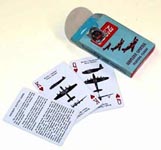 |
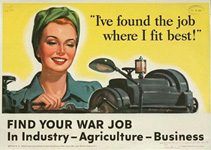 |
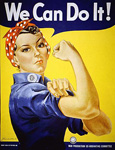 |
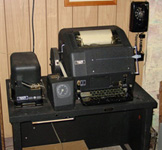 |
 |
 |
 |
 |
Women of the Pequot
This page tells the stories of the women who supported the sailors serving
aboard the U.S. Coast Guard
Cable ship Pequot during World War II. The Pequot served as a harbor defense
cable-laying and repair ship under direction of the US Navy. Her full story
can be found on the Pequot Home Page.
After the Japanese attack on Pearl Harbor the whole country geared-up for the war effort. It has been written that every American contributed directly or indirectly in some way. Scrap drives gathered up copper, rubber, steel, and aluminum, thousands of factories and businesses quickly converted to produce uniforms, guns, trucks, tanks and munitions. Aircraft plants and shipyards ran around the clock. Gasoline and food were rationed and cities along both coasts blacked-out their lights at night. The USO and the Red Cross went into high gear. The level of personal sacrifice and spirit of patriotism ran deep. Americans really pulled together. Everything was at stake.
The contribution of America’s women was key to achieving victory, and the wives, girlfriends, mothers, and sisters of the sixty-three men on the Pequot all had a part in the fight.
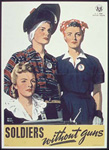 |
Civilian
Aircraft Spotter Quartermaster Ozzie Frontel’s future wife Violet was an aircraft spotter in Middlefield, Connecticut . During the war, Army Air Forces Ground Observer Corps established a network of more than 1,500,000 civilian airplane spotters who kept a vigilant watch for enemy planes in the skies over America. Violet and a school friend pulled regular duty in an observation tower overlooking the reservoir near Middlefield. Spotters like Violet were trained using a special deck of “spotter” playing cards which had the silhouettes of enemy aircraft on them. (Photo: Army Signal Corps, First Service Command). |
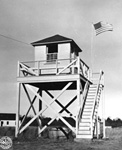 |
 |
Inspector for the US Navy Lou Carhart’s mother, Elizabeth and step-father, Max Shumacher worked in Southgate, California as inspectors for the Navy. Along the West coast American and Canadian shipyards from San Diego to Vancouver produced and repaired tens of thousands of warships, Liberty ships, freighters, tankers, landing craft, and auxiliaries. Civilian workers like Lou’s mother were key to maintaining production and quality control. (Photo: Project Liberty Ship, USS Oxford). |
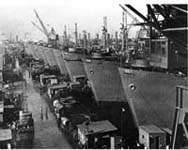 |
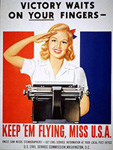 |
B-24 Bomber Plant Teletype Operator Lee Coppo, wife of Pequot Boatswains Mate, Martin, worked for the Army Air Corps at the massive “Arsenal of Democracy” Willow Run Ford plant near Ypsilanti, Michigan that produced 8,685 B-24 Liberator bombers during the war. “I began in early Nov 1942,” Lee writes. “The Air Corp did all the inspection work, and flight testing - there were officers and pilots everywhere. I worked in the Administration Building from four in the afternoon to midnight as a teletype operator. I sent and received hundreds of secret messages to and from places all over the United States. Everything was by code - all dots, dashes, numbers and letters. I had no idea what the messages were all about. Many well known people visited our office while touring the factory. I saw Charles Lindbergh, The actress Jeanette MacDonald, and the Premier of France Charles de Gaulle. I really enjoyed working for the Air Corps, but after I married Martin I wanted to move to Boston. Being released from government war work was very difficult, but eventually an Air Force Captain from Texas went to bat for me and I finally received my release notice on March 18, 1944. A week later I was on a train for Boston." (Photo: 3509th Army Air Force Base Album, Henry Ford Museum, February 15th 1944). |
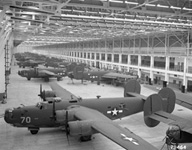 |
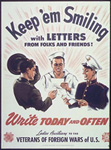 |
Department Store Servicemen Photographer Elsie Straight, wife of Pequot Yeoman Clarke, worked at the Porteous, Mitchell, and Braun department store in Portland, Maine. She gave away coupons to servicemen for free photo session and actually won a prize for the most free portraits taken of servicemen, many with their wives or girlfriends. In fact there is a very real possibility that the color portrait of Martin and Lee Coppo in his story on this website was taken by Elsie or one of her co-workers. (Vintage Postcard 1920, Remembering Great American Department Stores). |
 |
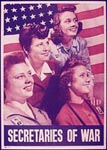 |
War Department Secretary Frances McCormack wife of Pequot radioman John, left her home in Sebec, Maine and went to Washington DC where she worked as a secretary for the War Department. Thousands of women from across America traveled to the nation’s capital to work not only in the War Department but in all other federal agencies. To accommodate the massive build-up of administrative support needed to run the business and logistics end of the war, rows of “temporary” office buildings were quickly put up along the capital mall. Many of those pre-fabricated buildings left over from WWI remained in service well into the 1970s before they were removed. During the war John and Frances first met on the mall near her office when he was sitting on the grass reading a newspaper. (Photo: US Navy Photo, National Archives and Records Administration). |
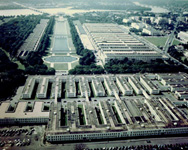 |
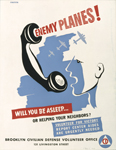 |
Telephone
Operator Reba Freiermuth, wife of Pequot Seaman Paul worked as a telephone operator for Ohio Bell throughout the war. Reba recalls, “We couldn’t wear nylon stockings to work since the nylon was needed for parachutes, and I remember going to dances with my friends a few times but all the women ended up dancing together because most of the men were gone. We also had black out drills where everyone turned off all their lights, so if enemy planes came over they would have a hard time telling where we were.” As a Bell employee Reba was allowed one free long distance call per week so she would write to Paul and mail him letters to pre-schedule those precious phone calls when the Pequot was in port. (Photo: Ohio Historical Society). |
 |
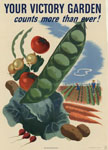 |
Mom’s Victory Garden Clarice Freiermuth mother of Pequot Seaman Paul, kept a thriving Victory Garden throughout the war at the family home in Zanesville, Ohio. With war rationing and so much food headed overseas to the troops, Americans were encouraged to plant Victory Gardens to help feed everyone on the homefront. In addition to backyard gardens like Clarice’s, crops were planted in front of municipal buildings, around schools, and in common areas within many communities. In the photo on the right we see Clarice with Paul’s wife Reba surrounded by the bounty of her efforts. Click photo to the right to get an enlarged view. (Photo: Freiermuth family). |
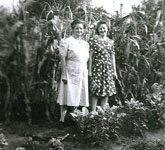 |
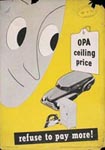 |
Office of Price Administration Inspector After Catherine Calamaio married Pequot Gunners Mate Roger, she moved to Boston and took a job as an inspector for the Office of Price Administration (OPA). The OPA was put in place immediately after Pearl Harbor through executive order by President Roosevelt in an attempt to contain the wartime inflation the US experienced during the first world war. Rents were controlled, goods, food, and gasoline were rationed, and the government stepped in to control consumer prices. Using a daily checklist, Catherine traveled incognito throughout the greater Boston area visiting grocery stores, butcher shops, and other business to record what they were charging for meat, bread, sugar, coffee, and dry goods. By V-J day the agency reported that prices had increased by 31 percent since Pearl Harbor, far better than the 62 percent increase during WWI. (Photo: National Archives and Records Administration 208-AA-322I-2). |
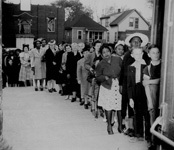 |
 |
Metal Lathe Operator Seaman Mike Luongo’s girlfriend, Angelina "Lee" Gengaro came to America from Italy with her family when she was about 8 years old. She was one of 10 children. Her father owed a butcher shop and as a young girl she would help out in the store. After high school graduation she took a job in a cigar factory. During the war years she operated a metal lathe for the Isolantite Corporation in Belleville, New Jersey. Working off blueprints, she would turn machine parts to the exact specifications required, check her work with a micrometer, and send the parts on down the line. She knew the company was doing war work but had no idea what the pieces she fabricated were used for. Lee married Mike after he was discharged and worked later in life as a seamstress. (Photo: National Film Board of Canada / Library and Archives). |
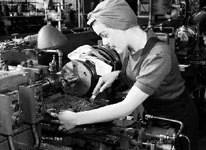 |
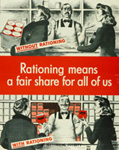 |
Sign Manager F.W. Woolworths Norma Zavitz who married Pequot Quartermaster Bob Livingston after the war, worked as the District Sign Manager in the art department for the F.W. Woolworth Company in Columbus Ohio. Woolworths like all large American retailers found themselves in the middle of the rationing and price control hardships of the war years. Long established national corporations like the dime store and soda fountain chain did their best to stay in business, support the war effort, and remain a central part of the American culture especially in smaller cities and towns. (Photo: National Conservation Centre, Archive reference 9123-1). |
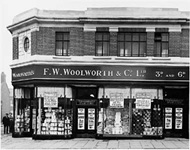 |
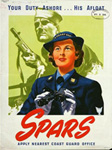 |
Lieutenant U.S. Coast Guard Spars Maxine Eberle, wife of Pequot Storekeeper William C. Eberle was a full lieutenant in the Coast Guard Spars. Women who joined the Spars went through the exact same rigorous basic training as all newly enlisted Coast Guard men. During the war the Spars served on shore stations along both coasts as far North as Alaska. They kept the Coast Guard running and served not only as clerical support, but also as maintenance workers, radio dispatchers, communications specialists, logistics coordinators, coxswains, air traffic controllers, and as technicians in the top secret Loran project. Maxine was part of the elite 955 member Coast Guard Spars Officer Corps. For more information on the Coast Guard Spars of World War II see: http://www.uscg.mil/History/WomenIndex.asp. (Photo: US Coast Guard). |
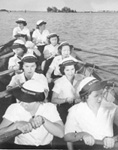 |
|
To learn more about WWII rationing on the Homefront see: http://www.ameshistoricalsociety.org/exhibits/events/rationing.htm |
Every effort has been made to trace and acknowledge copyright. The authors would welcome any information from people who believe their photos have been used without due credit. Some photos have been retouched to remove imperfections but otherwise they are true to the original.
FEEDBACK
If you have comments or queries specifically
about the Pequot, please contact
Chip Calamaio
chipaz@cox.net, 938 E. San Miguel Avenue, Phoenix, 85014, Arizona,
USA. (H) 602-279-4505.
Click here to go to the Pequot Main Page.
Research and design: Chip Calamaio and Richard Walding